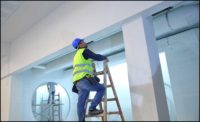My last security and resilience column discussed the Leadership in Energy and Environmental Design (LEED) pilot credits for resilience. The three potential credits were discussed in a general sense and some indication as to how to achieve those credits was explained. Two of the credits, those dealing with assessment, planning, and passive survivability, are fairly straightforward, and the means of obtaining the credit were outlined. The other resilience credit, “Designing for Enhanced Resilience,” is a bit more complex with specific guidelines for various hazards. This column will look at the specific measures that designers must implement to receive the credit.
The LEED credit for “Designing for Enhanced Resilience” addresses specific hazards, including flooding, sea-level rise, wildfire, hail, hurricanes, and high wind areas, tornado, earthquake, tsunami, drought, landslides, extreme heat, and winter storms. Each hazard has one or more options available for meeting the credit criteria, generally referencing other standards and guidelines. Note that only two of the top three hazards identified in the assessment and planning phase need to be addressed. I will examine a few of the hazards in detail, outlining the specific steps that should be undertaken to achieve enhanced resilience.
Flooding
Flooding has two options for compliance, both of which identify specific measures that should be implemented. The first option uses the RELi guidelines and includes measures, such as providing backup power or hookups for critical utilities, such as boilers and HVAC, locating equipment above the 500-year floodplain or for existing structures with equipment located within the 500-year floodplain developing a detailed flood-protection plan. The second option requires the lowest occupied floors’ structural support to be at least 3 feet above the base flood elevation. Alternatively, an engineer may certify that dry flood-proofing practices are being followed, or the design must be in compliance with Executive Order 13690 Federal Flood Risk Management Standard with some additional requirements.
Sea Level Rise
Sea level rise is primarily concerned with accommodating storm surge. Except for significant, high-risk, or mission-critical projects, facilities should accommodate the Category 2 hurricane and storm surge with minimal or no interruption of services. In addition, key functions or service areas should be protected from the expected storm surge from a Category 4 hurricane. Finally, significant, high-risk, or mission-critical facilities should provide the same levels of protection but for Categories 3 and 5.
High Winds and Hurricanes
High winds and hurricanes (as differentiated from the associated storm surge) are assumed to achieve enhanced resilience if they are designed as bronze, silver, or gold levels in the fortified commercial system. Alternatively, in high-wind, non-hurricane regions, projects can be designed for the requirements of American Society of Civil Engineers (ASCE) 7, which is the standard design process. This raises an interesting question, since compliance with ASCE 7 is required under the building code — both the International Building Code (IBC) and International Residential Code (IRC). Thus, does meeting the ASCE 7 requirements constitute enhance resilience or just life safety, as is the code intent? Designing for Enhanced Resilience for some of the hazards involves following the requirements of specific standards.
Wildfire & Tornado Protection
Wildfire protection is achieved by following the 2012 ICC Wildland-Urban Interface Code or the 2013 National Fire Protection Association (NFPA) 1144.
Similarly, tornado protection is provided by following either FEMA P-361 for safe room design or ICC 500 for storm shelters. Finally, earthquake protection is predicated on achieving at least a Silver rating in the ARUP REDi rating system. The requirements for other hazards can be found in the LEED documentation.
The specific design requirements for obtaining the LEED pilot credit for Designing for Enhanced Resilience cover the wide range of expected hazards. For the most part, these requirements are above and beyond the standard code-required design levels. The reliance mainly on external guidelines and standards provides flexibility and allows for third-party vetted solutions to be utilized. Officially, the designers are required to consider only two of the top three hazards identified for the site. While, in many cases, this may provide adequate resilience, it’s important to coordinate with the desires of the owners and local jurisdiction. There may be other hazards or higher levels of protection for the identified hazards, that should be considered. The major conclusion of this review is that application of the requirements of the LEED pilot credits will result in a more resilient building and going beyond to additional hazards or design features will only improve on that resilience.





